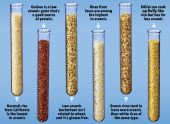As I noted earlier, the first round of proposed rules for produce and processing were withdrawn.
https://permies.com/t/30711/large-farm/FDA-agreed-propose-rules-farms
Just so y'all understand the federal agency process, I will provide a brief description. Congress drafts and passes a law (that has to be enacted by the President), which has certain dictates but generally grants broad discretion to the agencies to write rules to effectuate the law and enforce it. The agencies have to follow certain processes in order for their rules to be valid. An agency such as the FDA must release its rules in proposed form, stating legal basis for the rules, providing policy justifications, providing a timeline for implementation, analyzing economic impacts, and estimating costs of compliance by effected entities or persons. The is called a proposing release and is published in the Federal Register and at regulations.gov, and sometimes on the agency website. Next, the agency must provide a period of public comment on the proposed rules. Comments can be sent via snail mail and uploaded to regulations.gov. Once the comment period is closed, the agency then sorts through the comments. It drafts what is called an adopting release. At this point, the agency must respond to the comments received. It can justify adopting the proposed rules despite public comment objections, or it can change the rules to deal with the comments. The agency also has the discretion to say the rules as proposed needs substantial revision, so it will revise and repropose the rules for comment again. This is the case with the FDA's original proposals for produce and processing.
The first proposed rules were a disaster. Here are a few examples. First, the agency made the small farm exemption that was set out in the legislation revocable, but provided no means for a revocation proceeding or a means for reclaiming the exemption. This flaw was a clear violation of the Due Process Clause of the 5th Amendment and tons of other legislation and case law. Second, the costs of compliance were estimated at approximately $13K annually. Even if you have gross sales at $500,000 and a net income margin of 10%, the estimated compliance costs were over 25% of a farm's net income. This is a grossly disproportionate economic impact versus potential risks mitigated. Third, the gross sales number aggregated all farm sales. However, meat issues are regulated by the USDA and the states. That regulatory regime is decades old and the legislation did not address it. Aggregating the numbers from meat and produce is a jurisdictional overreach.
The new produce and processing rules are forthcoming. Please be ready to review them and provide comment on how they effect you. The agency does have to consider your comment, and the comment can later serve as a basis for challenging adoption or application of the rules in court. I am sure there will be discussion of any new proposal here. And even if you are not a member of the Farm to Consumer Legal Defense Fund, you can sign up for their email newsletter that will alert you to issues such as this. They also provide instructions on the regulatory comment process and some sample comment language.


 5
5















 1
1








 2
2




 1
1



































 4
4













